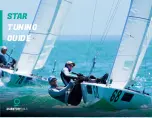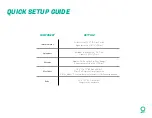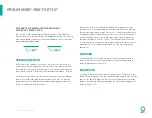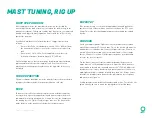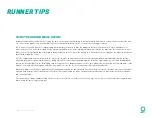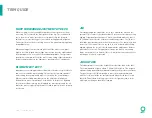
S TA R / T UNIN G GUIDE
MAINSAIL
The mainsheet control is the most important control on the boat. The
mainsheet is something you should be adjusting constantly whenever
there is a change in wind velocity and water conditions and based on the
mode of the boat or when making a maneuver. Be sure to experiment to
find that right degree of trim for the day.
OUTHAUL
The outhaul should have a range of adjustments from the foot of the
sail touching the boom to about 8” off the boom for downwind. This will
give you a range for any condition and point of sail. The best guide for
the outhaul upwind is from 0-4 knots; the outhaul should be snug to the
boom. when you’re in 6-8 knots of air and trying to generate power to
hike against, ease your outhaul up to 1½”. In over 10 knots of air, tighten
the outhaul to flatten the sail and reduce power.
Downwind, the outhaul should be eased to make the sail full. Ease it so
that the shelf foot opens.
CUNNINGHAM
The trick with the cunningham is not to overuse it. Leave some horizontal
wrinkles in the main in conditions under 8 knots. Leaving these wrinkles
gives the main the power it needs to get through the softer air. As the
wind increases, use the cunningham to balance the boat. If the boat feels
slow, ease the cunningham to return the power to the mainsail. On the
downwinds, the cunningham should come off completely.
BACKSTAYS
The Star has upper and lower backstays. The upper is attached to the
same spot as the headstay and helps tighten your forestay and depower
TRIM GUIDE
your main, while the lower controls mast bend below the spreaders.
Both backstays change the amount of headstay sag. In light air under 6
knots, the backstays should be off or just snug. In over 6 knots of wind,
the lower backstay should be loose or about 1” from slack. When the
crew is just over the side, you want to pull on more lower backstay to
generate more power. When it’s windy, you’ll want to ease the lower
backstay to go faster forward. Tighten as needed to keep height and the
main quiet in the biggest breeze. The lower backstay also controls the
headstay sag and the slot between the jib and the mainsail. To reduce
power in the sails, pull on more lowers, and to increase power, ease off
the lower backstay.
The upper backstay controls the upper part of the mainsail. This control
is best used when the boat is overpowered. When the wind comes up,
the lower is the first backstay to go on. When you need more balance or
the boat is overpowered, the upper comes on to help flatten the boat. A
tighter backstay will help the boat go lower and faster in heavy air, and a
looser backstay will tend to make the boat point higher with less speed.
When reaching, the backstays should be eased to make the mast vertical
to reduce the helm.
When running, both backstays should be eased so that the mast can go
forward. In light breeze, the backstay should be fully eased so the mast
can get as far forward as possible. In heavy air, the backstay should be
eased, but be careful not to go too far forward (more than 15”-20”) or the
boat may become unstable.
The crew should check the leech at the top batten to make sure it is not
too tight. We define too tight as when the leech doesn’t move or is very
tight. You will find that you need very little vang on a run. The rule is the
same as trimming the leech upwind: Keep the aft end of the top batten
parallel to the boom or looser.
Содержание STAR
Страница 1: ...STAR TUNING GUIDE ...

